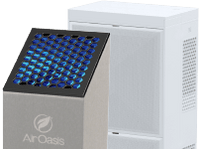Airborne Allergens
Allergens in the Air
When there are allergens in the air, certain sensitive individuals can experience all kinds of unpleasant symptoms. Someone might get a runny nose and start sneezing from allergies. Someone else might develop an itchy and unsightly rash, and another person could experience swelling or even have trouble breathing due to allergies. Those who are sensitive to allergens could experience any or all of these symptoms, and the severity of the symptoms can vary from person to person as well. In certain cases, an allergic reaction can even be life-threatening. Anaphylaxis is an example of a reaction that, if untreated, can be fatal. Symptoms of anaphylaxis include shortness of breath, a drop in blood pressure, and a loss of consciousness.
What Causes an Allergic Reaction?
Reactions can be caused by many different kinds of substances, but common airborne allergens include dust mites, mold spores, pet dander, and pollen. In the body of an allergic person, many of these substances may be seen as foreign invaders, causing the immune system to overreact. The immune system of an allergic person responds to the perceived health threat by making antibodies called Immunoglobulin E, or IgE, which identify specific allergens as dangerous, even though on their own, they are relatively harmless. These substances become harmful only because of the body’s reaction to them. When an allergic person inhales allergens in the air, IgE antibodies instruct cells to release chemicals like histamines, which cause an allergic reaction.
For an individual with an allergic condition, it can be unpleasant or even potentially life-threatening when certain allergens are airborne. Allergies affect some people and not others, and they can come and go in a person’s life. It isn’t uncommon for someone who develops an allergy as a child to outgrow that allergy, nor is it unheard of for the allergy to return later in life. Individuals are more likely to develop an allergy if they have a family history of allergies, and having one kind of allergic condition increases the chances of having another.
Will an Air Purifier Help With Allergies?
For a person with an allergic condition, avoiding the substances that trigger allergic reactions is the most effective way to prevent those reactions. However, when the allergens are airborne and invisible to the human eye, avoidance can be difficult. Someone faced with such a situation may be wondering what to do. Air purifiers help. Allergies can be alleviated with the use of an effective air purifier from Air Oasis. Studies conducted by Dr. Nabarun Ghosh at West Texas A&M University showed that our air purifiers greatly reduce the number of allergens in a home over time.
Our air purifiers are especially effective at reducing carbon-based contaminants, such as mold spores, which can cause allergic reactions.
Which Air Oasis Air Purifier is the Right Fit?
When dust mites, pet dander, and mold spores become airborne, allergies can seriously debilitate someone with an allergic condition. With the purchase of an Air Oasis air purifier, however, improving the indoor air quality of commercial and residential buildings is exceedingly easy. We produce a number of different models that can quickly reduce the number of allergens in a home. Our countertop models are perfectly suited to clean the air in specific problem rooms in a building. The iAdaptAir® Small can greatly reduce airborne allergens in spaces around 200 square feet, making it a great fit for bedrooms, bathrooms, and offices. The Air Oasis iAdaptAir® Medium, ideal for master bedrooms, living areas, and kitchens, can sanitize the air in spaces up to 530 square feet. These models can help if there are particular rooms the allergic person spends a lot of time in.

